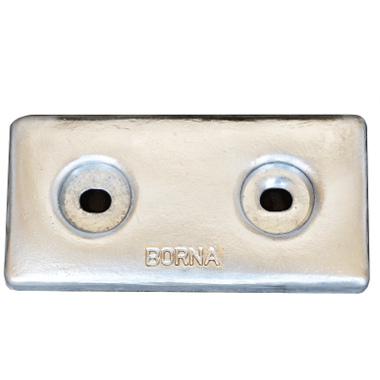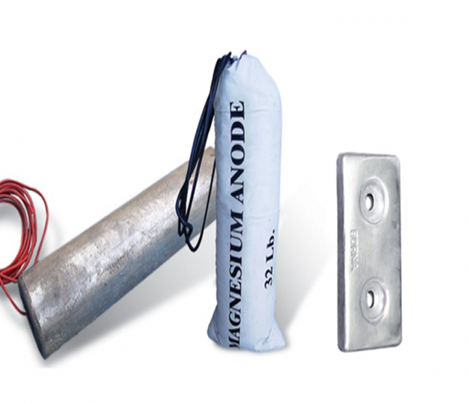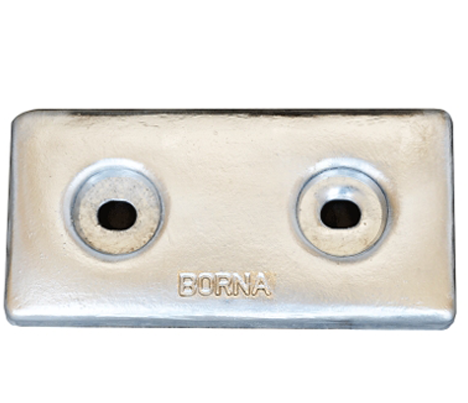Magnesium anode
Category: sacrificial anode
Magnesium anode
Magnesium is the most common sacrificial anode used to protect structures buried in soil.

sacrificial anode

Magnesium anode
Magnesium is the most common sacrificial anode
Magnesium anode:
Magnesium is the most common sacrificial anode used to protect buried structures.
Magnesium anodes are also used for internal protection of water heaters and water tanks, heat exchangers, condensers and other structures that are in contact with water.
Common standards for magnesium anodes include ASTM-B 843, ASTM-G 97, BS 7361, IPS-M-TP-750 and NACE-RP0387.
Magnesium anodes are divided into the following two categories in terms of chemical composition and type of application:
1) Standard magnesium anode (AZ63)
2) high potential magnesium (M1C)
| High Potential | Standard | Element |
| 0.01 max | 5.3 – 6.7 | Aluminum (%) |
| — | 2.5 – 3.5 | Zinc (%) |
| 0.5 – 1.3 | 0.15 – 0.7 | Manganese (%) |
| 0.05 max | 0.1 max | Silicon (%) |
| 0.02 max | 0.02 max | Copper (%) |
| 0.001 max | 0.002 max | Nickel (%) |
| 0.03 max | 0.003 max | Iron (%) |
| 0.3 max | 0.3 max | All Others (%) |
| Remainder | Remainder | Magnesium (%) |
According to the NACE-RP0387 standard, the insert used in magnesium anodes must be made of galvanized steel.
According to the BS 7361 standard, the open circuit potential of magnesium anode is about -1.7 V compared to the copper/copper sulfate reference electrode, while the open circuit potential of the standard magnesium anode is about -1.5 V compared to the copper/copper sulfate reference electrode. The electrochemical capacity of standard and high potential magnesium anodes is at least 1200 A.h/kg and their consumption rate is at most 5.7 kg/A.year. The efficiency of high potential magnesium anode is about 50% and the efficiency of standard magnesium anode is about 60%.
| High Potential | Standard | Electrochemical Properties |
| 1200 | 1200 | Electrochemical Capacity (A.h/kg) |
| 1.7- | 1.5- | Open Circuit Potential (V) (Respect to Cu/CuSO4 Reference Electrode) |
| 50 | 60 | Efficiency (%) |
For cathodic protection of structures buried in the soil, it is very desirable to use backfill around the anode. The function of the back strap material is:
1) Stability of anode potential
2) prevent anode polarization
3) reducing the resistance between the anode and the soil and increasing the output current of the anode
4) By creating uniform corrosion in the anode, it reduces the self-corrosion of the anode and increases its efficiency.
Usually, the back material is a mixture of gypsum, bentonite and sodium sulfate.
Resistivity Ohm.cm | Sodium Sulfate% | Bentonite Clay% | Gypsum% : CaSO4 | |
Molding Plaster | Hydrated | |||
| 250 | — | 75 | — | (A) 25 |
| 250 | — | 50 | — | (B) 50 |
| 250 | — | 50 | 50 | (C) — |
| 50 | 5 | 20 | — | (D) 75 |
1) The composition of the back band (A) is suitable in areas with low soil moisture because the bentonite contained in it has the property of retaining water.
2) Backing compound (B) is commonly used for zinc anodes.
3) Backing compound (C) is suitable for magnesium and zinc anodes in very wet and swampy soils because it holds itself well around the anode.
4) The compound behind the band (D) has a low specific resistance and is suitable for areas with high soil specific resistance in order to reduce the resistance between the anode and the ground.
According to the IPS-M-TP-750 standard, the granulation of the backing material should be such that 100% of its particles pass through the sieve with 0.84 mm holes (20 mesh) and 50% of its particles pass through the sieve with mm holes. 0.15 (mesh 100) should remain. Also, the humidity behind the strap should not be more than 5% (if the humidity behind the strap is high, the anode will corrode during storage).
Technical documents of Bernagdaz magnesium sacrificial anode:
Single hole magnesium anode data sheet sample (standard alloy – 0.5 kg)
Sample report of chemical analysis of magnesium anode – standard alloy
Sample report of electrochemical analysis of magnesium anode – standard alloy
Sample report of chemical analysis of magnesium anode – high potential alloy
Sample report of electrochemical analysis of magnesium anode – high potential alloy
Obtaining approval from the Iranian Classification Institute
Technical catalog of magnesium sacrificial anode – Persian version
Magnesium sacrificial anode technical catalog – English version

